Cure your winter blues with a steamy pot of Japanese Kimchi Nabe. Made with anchovy broth, kimchi, pork belly, and vegetables, this soup pot is hot and sour with a good kick of spice that warms you right up!
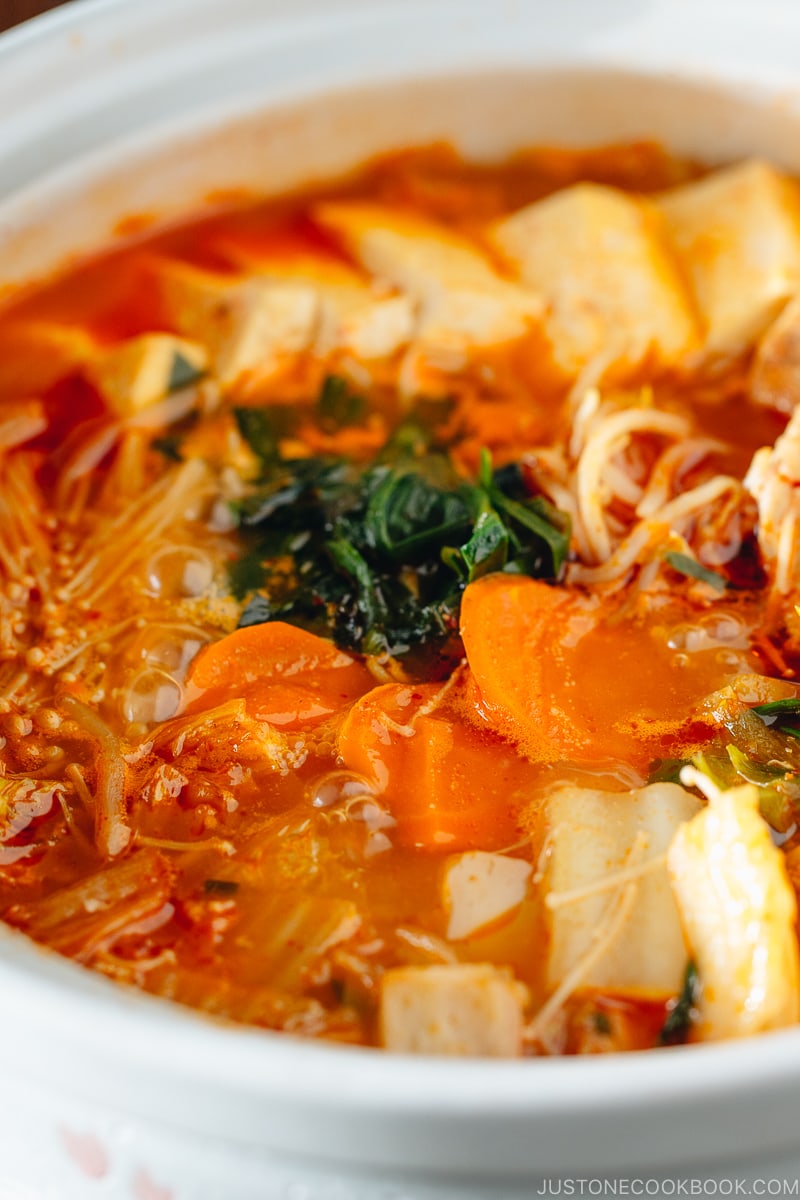
As cold weather continues in most of the Northern hemisphere, I’d like to share another Japanese hot pot recipe with you.
Today we’re cooking Kimchi Nabe (キムチ鍋). Back in the early 2000s, Japanese TV stations started to broadcast Korean drama series. At that time the Japanese were exposed to more Korean foods that were relatively new to them. One of the Korean dishes that became popular in Japan was Kimchi Jjigae, Korean Stew.
Japanese started to make their version at home and in restaurants and called it Jjigae Nabe (チゲ鍋). Then they learned that Jjigae and Nabe have similar meanings and that the word “Jjigae” in Japanese implies spicy Korean food. So these days people call it Kimchi Nabe.
Now you are probably wondering if Kimchi Nabe is the same as Kimchi Jjigae, or how different they are. So let’s get started.
Kimchi Jjigae vs. Kimchi Nabe
First thing first. Are they the same or different? The quick answer is yes and no.
Kimchi Jjigae was introduced to Japan but after some time, the Japanese people adjusted the flavors to their liking (less spicy) and added more vegetables to this dish that are not used in Kimchi Jjigae. Also, the Japanese use a big donabe for this dish and treat it like a nabe (hot pot) instead of a single serving Korean stew.
As a result, this dish is no longer authentic Kimchi Jjigae anymore. So yes, it’s similar but not authentic enough to call Kimchi Jjigae.
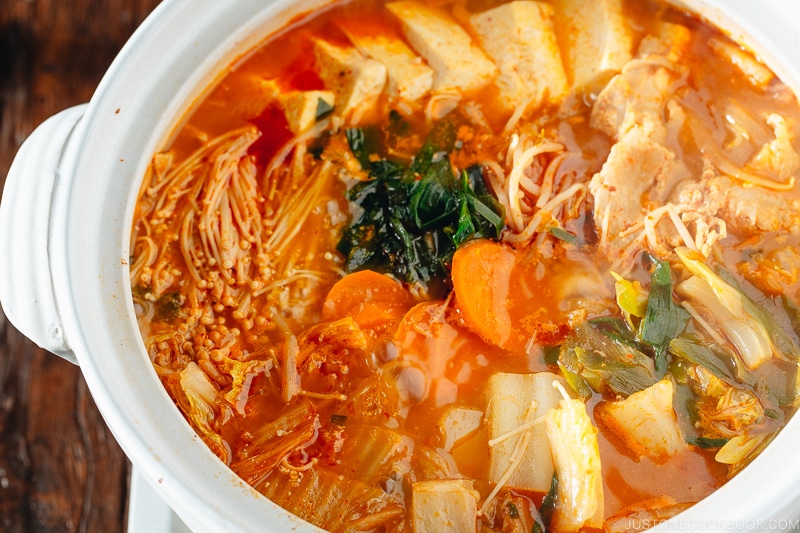
So… How did the Japanese adopt Kimchi Jjigae?
Each household makes this dish differently, but here are some of the “general” changes that I could think of:
Ingredients
- Just like other hot pot dishes, napa cabbage leaves are added to Kimchi Nabe in addition to kimchi. Kimchi Jjigae includes napa cabbage kimchi but does not include raw napa cabbage leaves.
- Typical hot pot ingredients are added to Kimchi Nabe, including napa cabbage, enoki mushrooms, Negi (long green onion), shiitake mushrooms, carrots, shirataki noodles, deep-fried tofu, and other hot pot ingredients.
- One thing that Kimchi Nabe does not usually include, but Kimchi Jjigae sometimes includes is an onion. Onion is not a common vegetable to add to a Japanese hot pot (but we do put green onion or long green onion (Negi).
- For the majority of Kimchi Nabe enjoyed in Japan, (Japanese) miso is added to the broth for more savory umami flavors and less intense spiciness.
- At the end of the meal (we call Shime, 〆), Japanese people like to put rice or udon noodles (sometimes ramen/Chanpon noodles) in Kimchi Nabe.
Cooking Method
- To make Kimchi Jjigae, aged kimchi is used and it’s cooked with meat first to remove some pungency before adding broth. The Japanese kimchi sold in Japan is not as pungent and spicy as one in Korea; therefore, kimchi is often added directly to the broth of Kimchi Nabe.
- Ingredients are added to Kimchi Nabe in an organized way so that each ingredient stays in one location (think of a slice of pie) and avoids mixing up with other ingredients.
How To Serve
- Unlike Kimchi Jjigae that is served in a single pot, Kimchi Nabe is cooked in a large donabe, Japanese earthenware pot, and served at the table.
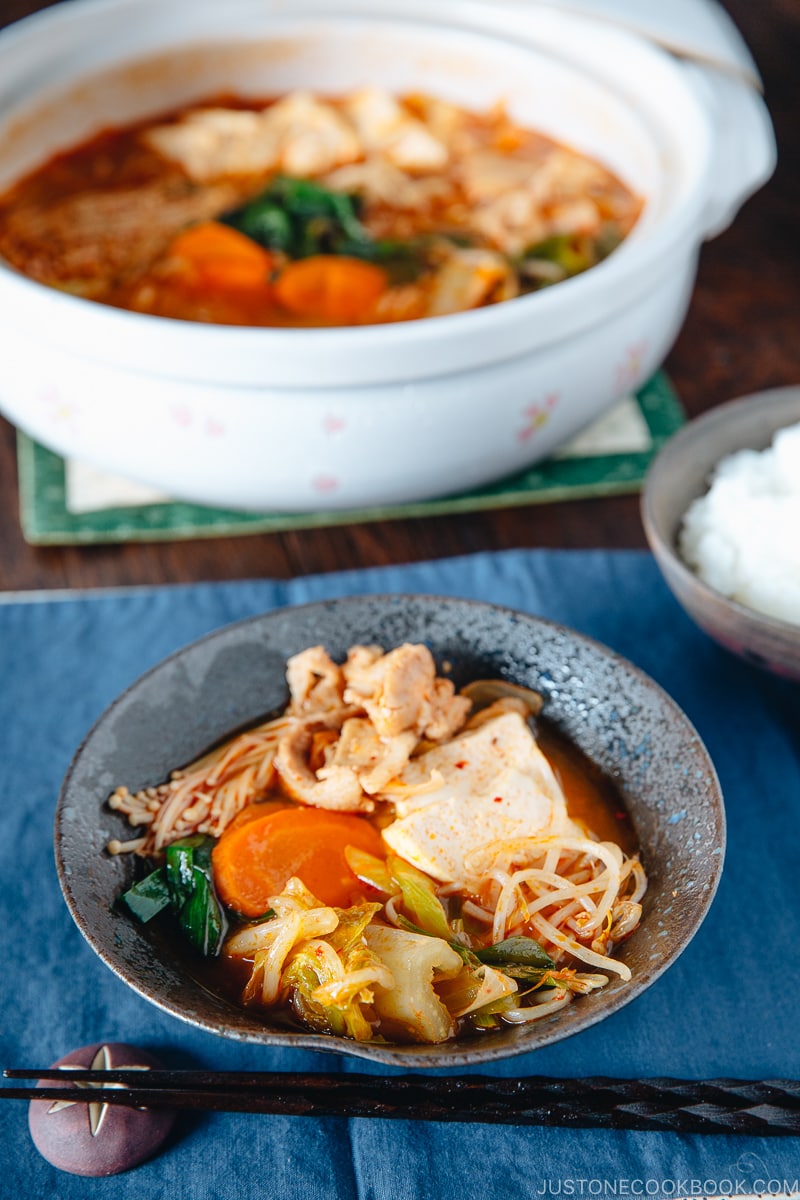
My Kimchi Nabe
I received quite a number of requests for the Kimchi Nabe recipe from my readers so I hope you like my version.
As I live in the U.S., and I’m more exposed to Korean foods, I decided to implement the Korean approach and cooked meat, kimchi and onion first. I use Korean kimchi instead of Japanese kimchi made in Japan, so I believe this method works best for my Kimchi Nabe.
Then I seasoned and added soup stock. Speaking of stock, I could have made it with typical Japanese dashi made of kombu and katsuobushi (bonito flakes). However, to make it a tiny bit closer to the original Kimchi Jjigae flavor, I used iriko (dried baby sardines/anchovies) and kombu. You could substitute with chicken broth as well, but I really encourage you to make your own broth with kombu and anchovies (or even bonito flakes).
If you don’t eat spicy food, reduce the amount of kimchi, gochujang, and gochugaru. The soup has good flavor from dashi already so removing the amount of spice won’t affect the final result too much.
Premade Nabe Soup Stock
Some people asked about premade nabe soup stock that is sold in Japanese grocery stores including Kimchi Nabe and Yosenabe, or Chanko Nabe. Those premade soup stocks seem convenient as all you need to do is to pour the soup broth into your pot and add fresh ingredients to it.
However, they include preservatives, MSGs, and unknown ingredients that I can’t pronounce if you look at the ingredients on the back. I highly recommend and encourage you to make your own nabe soup broth. If you make the soup stock (dashi) the previous day or before going to work, it’s really easy to put it together when you are ready to eat.
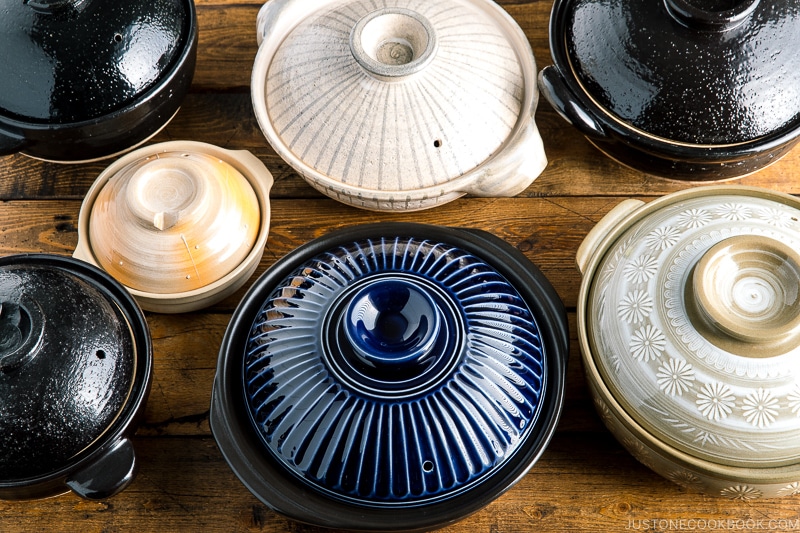
How to Season Your Donabe
By the way, if you have a donabe earthenware pot and don’t know how to season or take good care of it, I recommend checking out this post.
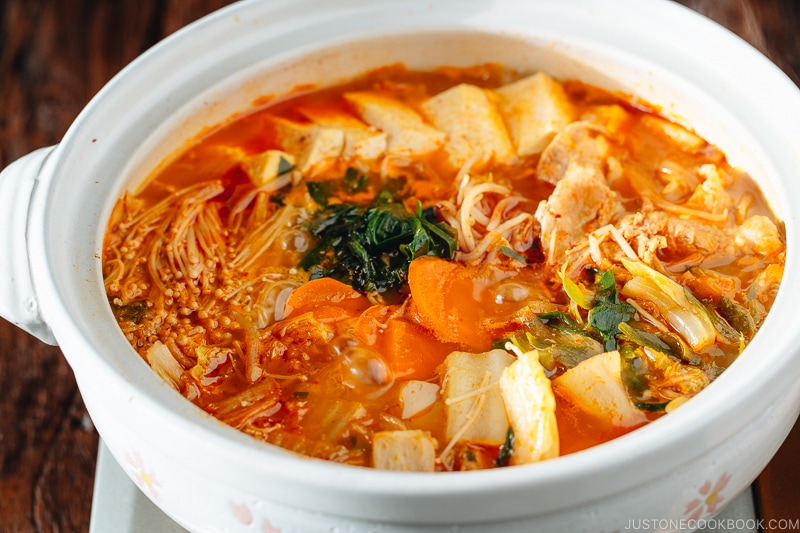
Wish to learn more about Japanese cooking? Sign up for our free newsletter to receive cooking tips & recipe updates! And stay in touch with me on Facebook, Pinterest, YouTube, and Instagram.
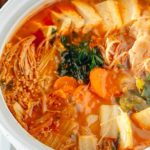
Kimchi Nabe
Video
Ingredients
- 1 lb kimchi (cut if necessary)
- ½ onion
- 14 oz medium-firm tofu (momen dofu) (1 pack)
- 6 leaves napa cabbage
- 1 Tokyo negi (naga negi; long green onion) (or 3 green onions/scallions)
- ⅓ carrot
- 3 stalks garlic chives (Chinese chives or Nira)
- 7 oz enoki mushrooms (1 pack)
- 6 oz bean sprouts
- 13 oz sliced pork belly (or use thinly sliced pork loin. If you can‘t get pre-sliced meat, you can freeze a block of meat for 30–60 minutes and slice thinly. See my tutorial here.)
- 1 Tbsp toasted sesame oil
- 4 cups dashi (Japanese soup stock) (see recipe below; or use chicken broth)
For the Dashi
- ¼ cup iriko/niboshi (boiled and dried anchovies)
- ⅓ oz kombu (dried kelp) (about 3 x 4 inches, 7.6 x 10 cm per ⅓ oz)
- 4 cups water
For the Seasonings
- 1 Tbsp sake
- 1 Tbsp gochujang (Korean chili paste)
- 1 tsp gochugaru (Korean pepper flakes)
- 1 Tbsp sugar
- 4 Tbsp kimchi juice
- 1 Tbsp soy sauce
- 1 Tbsp miso (you can use any type of miso)
- ½ tsp Diamond Crystal kosher salt
Instructions
- Gather all the ingredients.
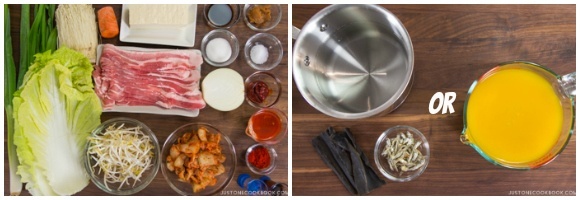
To Make the Dashi
- This is an extra step and not everyone follows this method, but I highly recommend removing the head and guts from the anchovies to reduce the bitter flavor in dashi (watch how I do it in this video).
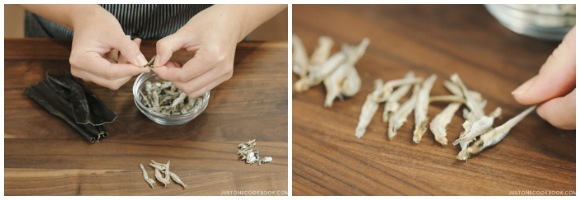
- Gently clean ⅓ oz kombu (dried kelp) with a damp cloth (but don‘t wipe off the white powder—that‘s umami!) In a small saucepan, put 4 cups water, the kombu, and ¼ cup iriko/niboshi (boiled and dried anchovies).
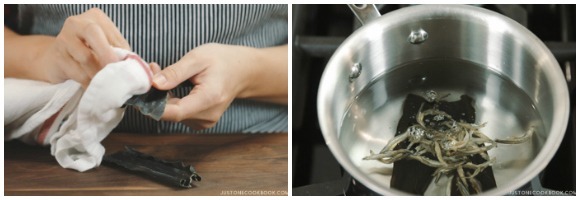
- Bring it to boil on low heat. It’s best to slowly infuse the water with the kombu and anchovies. Once boiling, cover and keep on low heat and simmer for 10 minutes.
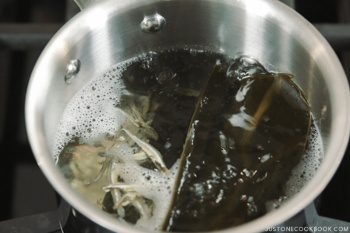
- Once you are done simmering the dashi, strain through a fine sieve. Set aside the dashi. Tip: With the spent kombu and anchovies, you can make candied anchovies and simmered kombu.
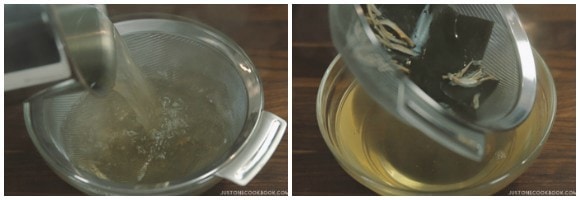
To Prepare the Ingredients
- Meanwhile, start prepping the ingredients. Thinly slice ½ onion. Cut 14 oz medium-firm tofu (momen dofu) into small blocks.
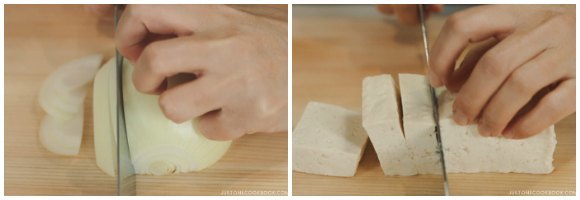
- Cut 6 leaves napa cabbage into 2-inch (5-cm) pieces widthwise (start cutting from the bottom toward the leafy side). The bottom part of napa cabbage is thicker, so cut these pieces into smaller pieces lengthwise (see how I do it in the video).
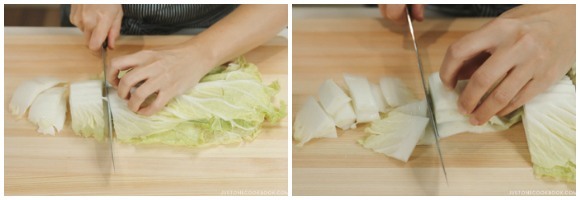
- Slice 1 Tokyo negi (naga negi; long green onion) diagonally into ½-inch (1.3-cm) pieces and slice ⅓ carrot diagonally into ¼-inch (0.6-mm) slices.
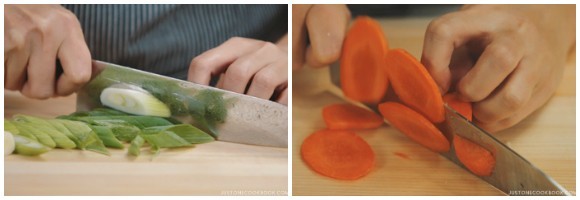
- Cut 3 stalks garlic chives (Chinese chives or Nira) into 2-inch (5-cm) pieces. Discard the bottom of 7 oz enoki mushrooms and loosen them up.
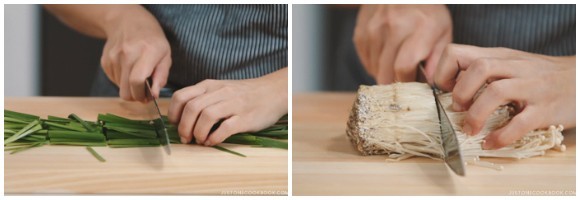
- Rinse 6 oz bean sprouts and place all the vegetable ingredients on a plate. Cut 13 oz sliced pork belly into 2-inch (5-cm) pieces and set aside.
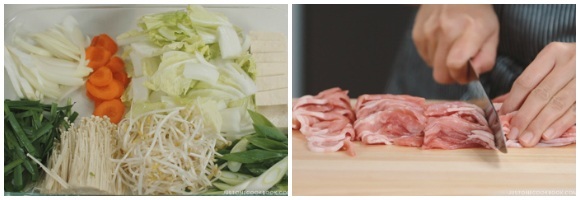
To Make the Kimchi Nabe
- In a large donabe (4–5 serving) or pot (use two donabe or pots if doubling the recipe), heat 1 Tbsp toasted sesame oil over medium-low heat and add the sliced pork belly. Stir-fry the meat until no longer pink.
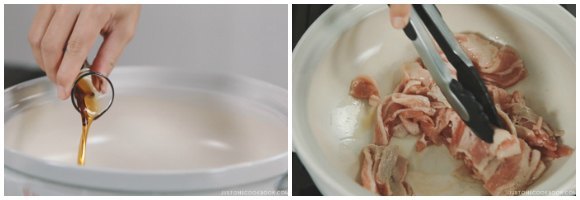
- Add 1 lb kimchi and onion and stir-fry for 5 minutes.
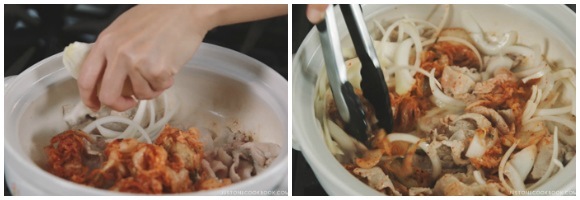
- Then add 1 Tbsp sake and 1 Tbsp gochujang (Korean chili paste).
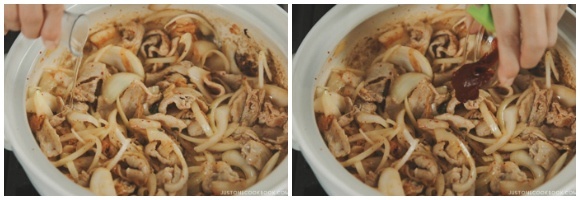
- Add 1 tsp gochugaru (Korean pepper flakes) and 1 Tbsp sugar and mix it all together.
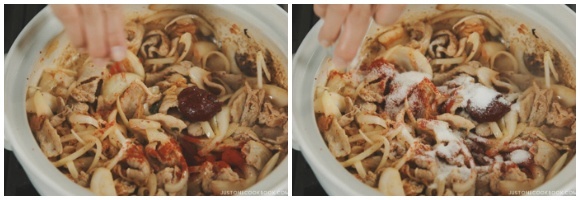
- Add 4 Tbsp kimchi juice and 4 cups dashi (Japanese soup stock) and make sure it’s mixed evenly.
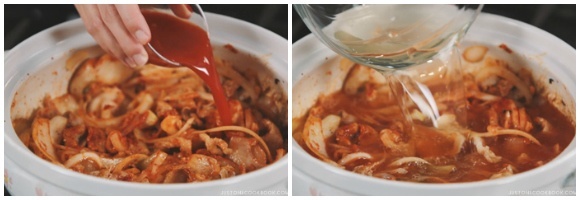
- Cover and bring to boil. Once boiling, reduce heat to low and cook for 5 minutes.
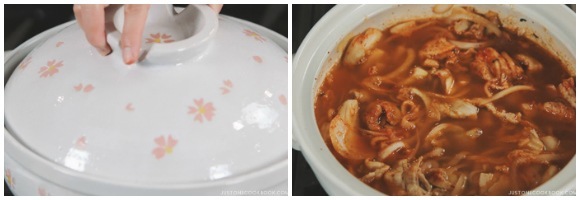
- Add 1 Tbsp soy sauce and 1 Tbsp miso. Mix all together and make sure the miso is completely dissolved.
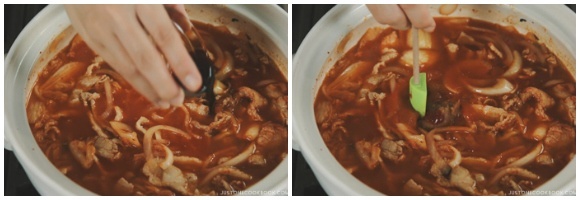
- Add the rest of ingredients and cover to cook on medium heat for 10 minutes, or until all the ingredients are tender.
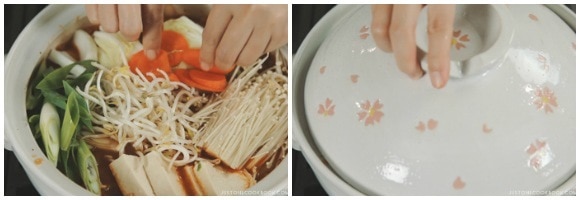
- Taste the soup and add ½ tsp Diamond Crystal kosher salt if necessary (I added about ½ tsp). Each miso has different saltiness, so you really need to taste the soup to adjust the flavor.
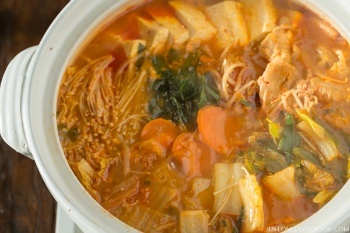
To Store
- You can keep the leftovers in an airtight container and store in the refrigerator for 3 days.
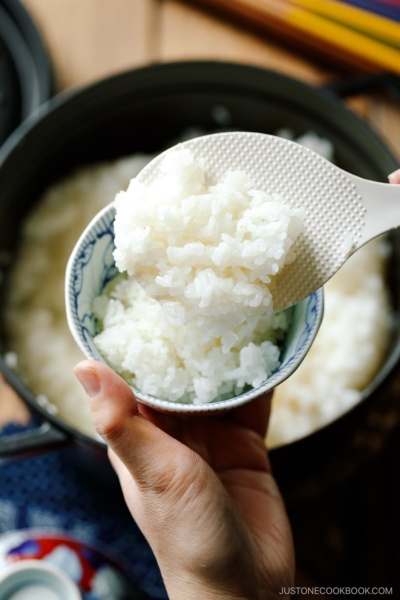
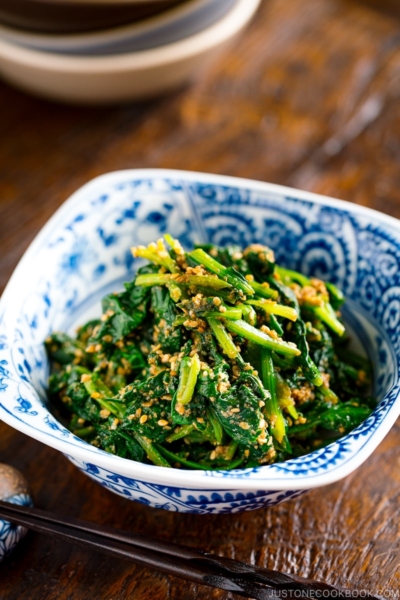
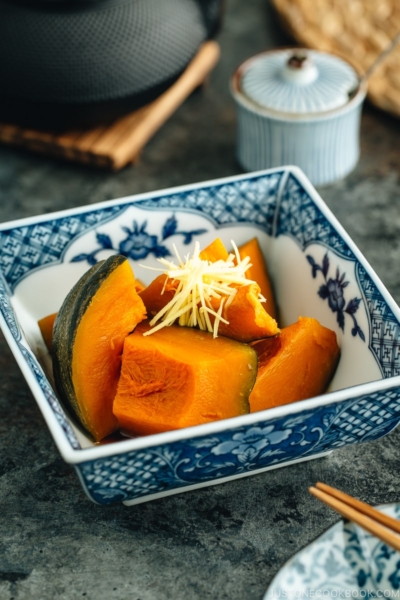
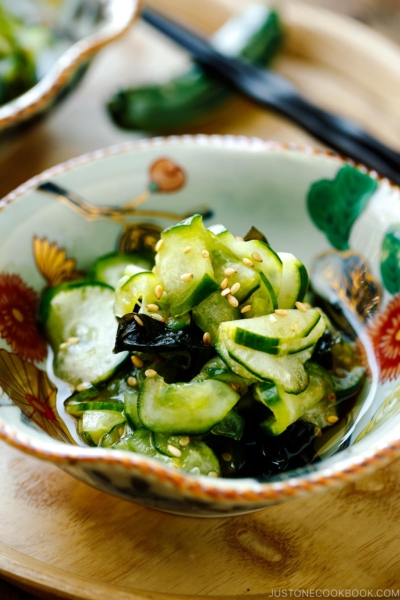




This recipe is FIRE!!! So freaking good!
Hello, Tegan. Thank you for trying Nami’s recipe.
We’re glad to hear you enjoyed this dish! We hope you’ll make it again soon! Happy cooking! 🤗
Delicious! I love kimchi jjigae, but now I also love kimchi nabe. My family likes the nabe better as it not as funky as the original.
Hi Scott! We are glad to hear you and your family enjoyed Nami’s Kimchi Nabe recipe!
Thank you for your kind feedback!🤗
Hi Nami! I can’t wait to try this recipe. but i was wondering will the kimchi stain tue donabe/be hard to wash off? Thank you!
Hi Sharon! Thank you very much for trying Nami’s recipe!
It is usually easy to wash off. Here is Nami’s other post that explains how to take care of Donabe. https://www.justonecookbook.com/how-to-season-your-donabe/
We hope this helps!
So very tasty! I used what I had…. leftover homemade dashi, no sprouts, I think it’s a forgiving recipe so long as you have good kimchi to build around. Taste as you go – much depends on the heat and saltiness of your kimchi – I did not need to add the gochugaru or extra salt – it was plenty hot and savoury for me without.
Hi Ann, Thank you very much for trying Nami’s recipe and sharing your cooking experience with us!
We are glad to hear it was tasty and you enjoyed it!
I lived in japan for a couple years and have been craving this ever since I’ve moved back to the US! I’m very excited to try this recipe. I didn’t find kimchi juice though, I found kimchi base. Is it the same thing?
Hi Michael,
We couldn’t be happier to hear how much joy and excitement Nami’s recipe has brought to you!
We are sorry that we’ve never used the Kimchi base before, so not sure how the outcome will be… please let us know how it goes!
Hello there
I’ve just ordered my first donabe and have been reading your advice and recipes. They look great by the way. Your site is so helpful and interesting. I just want to ask your advice on the following. It says to not heat the donabe without food or fluid in it and I can see you frying off onions in some recipes. Is it okay to heat the donabe just with onions and oil? I’m just nervous about starting out and don’t want to harm my donabe.
Thanks in advance for any advice.
Hi Tess! Thank you so much for your kind feedback on my website. 🙂 What they warn is called Kara-daki (empty heating) and that means to just heat the pot itself without any substance or liquid in it. If there is water or oil in it, it is not “empty heating” and you’re okay. The heat will burn the pot without food/liquid in it. When you have oil and onions then heat is used to cook them, so you’re not burning the pot. 🙂 Hope this helps!
Just found your site. I adore all foods Asian (well, mostly). Have you made this dish with dashi instead of anchovy broth? If so, how was it? I’ve made a variant of this dish before (I make my own kimchee), but making it with dashi intrigues me. And I’m not a big fan of pork belly, I’d probably just make it with thinly sliced pork.
Hi Maya! Welcome to JOC! Anchovy broth is a part of dashi that we call Iriko Dashi (different types of dashi here: https://www.justonecookbook.com/how-to-make-dashi-jiru/). Are you talking about the most known dashi with kombu and katsuobushi? Yes, you can use that. But I usually make it with Iriko Dashi. 🙂